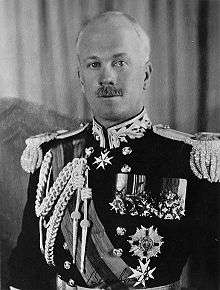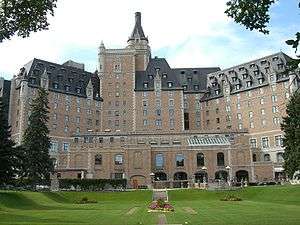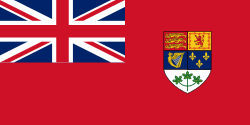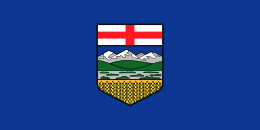Vere Ponsonby, 9th Earl of Bessborough
| The Right Honourable the Earl of Bessborough GCMG PC | |
|---|---|
 | |
| 14th Governor General of Canada | |
|
In office 4 April 1931 – 2 November 1935 | |
| Monarch | George V |
| Prime Minister |
Canadian • R. B. Bennett • W. L. M. King British • Ramsay MacDonald |
| Preceded by | The Earl of Willingdon |
| Succeeded by | The Lord Tweedsmuir |
| More... | |
| Personal details | |
| Born |
27 October 1880 London, England |
| Died |
10 March 1956 (aged 75) London, England |
| Spouse(s) | Roberte, Countess of Bessborough |
| Profession | Diplomat, businessman, and parliamentarian |
| Religion | CofE |
Vere Brabazon Ponsonby, 9th Earl of Bessborough, GCMG PC (27 October 1880 – 10 March 1956), was an Anglo-Irish businessman and politician who served as Governor General of Canada, the 14th since Canadian Confederation.
Born and educated in England into 'the Ascendancy', the Anglo-Irish aristocracy, he graduated with a law degree from Cambridge University before entering politics as a member of the London County Council and then, in 1910, as a member of the British House of Commons. Upon the death of his grandfather 10 years later, Ponsonby succeeded as Earl of Bessborough and took his seat in the House of Lords. He was in 1931 appointed as Governor General by King George V, on the recommendation of British Prime Minister Ramsay MacDonald, to replace The Earl of Willingdon as viceroy, and occupied that post until succeeded by The Lord Tweedsmuir in 1935. Lord Bessborough is remembered for promoting new communication technologies as well as giving support to the Canadian population during the Great Depression.
After the end of his viceregal tenure, he returned to London, where he continued in business and also work with the Dominions Office and the Foreign Office before his death in March 1956.
The 9th Lord Bessborough was the last Earl of Bessborough to own Bessborough House, the Ponsonby family's ancestral seat near the village of Piltown in the south of County Kilkenny in Ireland. The country house was largely built in the 1740s for the 1st Earl. It was gutted by fire during the Irish Civil War in February 1923. The 9th Lord Bessborough had the house rebuilt in the late 1920s. However, he sold the house in the late 1930s as he largely lived in Britain. The house now forms the main part of Kildalton Agricultural College.
Early life, education, and career
Ponsonby was born in London the first son and third child of Edward, 8th Earl of Bessborough, and his wife, Blanche. Her father, Sir Josiah Guest, was a great-uncle of Sir Winston Churchill. Ponsonby attended Harrow School before going up to Trinity College, Cambridge, in 1898, graduating three years later with a Bachelor of Arts degree.[1] In 1903, he began a career in law, being called to the Bar at the Inner Temple. After his father succeeded as Earl of Bessborough in 1906, Ponsonby used the courtesy title of Viscount Duncannon.
In 1907, the young Viscount Duncannon (as he then was) entered politics, being elected to a seat on the London County Council. He remained at that post until running in the January 1910 general election and winning a seat in the British House of Commons as the Member of Parliament (MP) for Cheltenham. He lost that seat in the election of 19 December that same year, but re-entered the Commons in 1913 as the MP for Dover.

Lord Duncannon married Roberte de Neuflize on 25 June 1912. With her he had four children: Frederick, born 29 March 1913; Desmond, born 4 August 1915; Moyra Blanche Madeleine, born 2 March 1918; and George, born 14 August 1931. Desmond, however, did not live past the age of 10, dying on 8 April 1925 from a riding accident,[2] and George, who was born in Canada and given the middle name St. Lawrence (after the river),[2] would also predecease his father on 16 May 1951.
By the following year, however, the First World War broke out and, whilst retaining his parliamentary seat, Lord Duncannon joined the army and was commissioned as a second lieutenant in Royal Buckinghamshire Yeomanry. He was transferred on 11 November 1914 to the Suffolk Hussars (both units were part of the Territorial Force and were sent into action overseas), where he was later appointed captain and promoted to acting major.[3] He served at Gallipoli in 1915 and, from 1916 to 1918, on the military staff in France. During his wartime service, he was mentioned in dispatches, awarded the Croix de chevalier of the French Legion of Honour,[4] and appointed to the Italian Order of St Maurice and St Lazarus, the Belgian Order of Leopold II, Greece's Order of the Redeemer, as well as a Third Class Member of the Russian Order of St Anna. At the conclusion of the war, Lord Duncannon was appointed a Companion of the Order of St. Michael and St. George in the 1919 New Year Honours List.[1][5]
After the death of his father on 1 December 1920, he succeeded to the Irish earldom of Bessborough, requiring him to resign his seat in the House of Commons and enter the House of Lords.[6] On 17 December, he applied to be Crown Steward and Bailiff of the Three Hundreds of Chiltern. The earl also pursued a successful business career, holding directorships in several large commercial firms, including acting as head of both the São Paulo Railway and the Margarine Union, as well as deputy chairman of De Beers Consolidated Mines.[7]
Governor General of Canada
It was announced in early 1931 that King George V had, by commission under the royal sign-manual and signet, appointed Lord Bessborough as his representative. This had been done on the recommendation of British Prime Minister Ramsay MacDonald, with input from Prime Minister of Canada Richard Bennett, and came as somewhat of a surprise, as Bessborough was the only businessman to have ever been appointed Governor General.
After being admitted into the Privy Council of the United Kingdom on 20 March 1931,[8] Lord Bessborough travelled to Canada and was sworn in as Governor General on 4 April, in the midst of the Great Depression. In his ensuing travels as viceroy, Bessborough witnessed the struggles of Canadians during this period, and praised their tenacity; in Shawbridge, Quebec, he stated in a speech: "There is nothing more encouraging and cheering than the calm steady way Canadians have pursued their daily tasks during the difficult period with a supreme faith in the destiny of their country."[2] As a sign of his sympathy with the majority of the populace, he gave up 10% of his salary.[7]

Despite the economic situation, Canada was gaining international stature and Lord Bessborough acted as host to the leaders who, in July 1932, converged on Ottawa for the Imperial Economic Conference. He also presided over the opening of the Welland Canal the same year. The Governor General welcomed a number of foreign dignitaries, including Prince Takamatsu and his wife, Princess Takamatsu; King Rama VII of Siam and his consort, Queen Ramphaiphanni; and Winston Churchill, then a British Member of Parliament. There were also a number of technological firsts that took place during Bessborough's tenure: his installation ceremony was the first to be broadcast by radio; in 1932, from the Governor General's study at Rideau Hall, he inaugurated the first trans-Canada telephone line by calling each of the lieutenant governors; and, as Governor-in-Council, he created the Canadian Broadcasting Corporation (the CBC). Lord Bessborough was also the first Canadian viceroy to fly the new standard dedicated to that office, created in 1931.[2]
Bessborough's time as Governor General coincided with the celebrations in May 1935 for the Silver Jubilee of the King's reign, part of which included his launching the King's Jubilee Cancer Fund with a radio broadcast from Rideau Hall, and also initiated a campaign to increase the membership of the Scouts. But the most prominent mark that Bessborough left on Canada was the Dominion Drama Festival,[9] which was developed with the assistance of future Governor General Vincent Massey and Henry C. Osborne and first held in April 1933, and awarded the Bessborough Trophy to the best amateur theatrical company in the country.[2]
Post-viceregal life
After life in Canada, Lord Bessborough returned to London and to his businesses. His activities were not all business related; during the Second World War, Bessborough helped in the establishment of a department in the British Foreign Office dedicated to the welfare of French refugees in the United Kingdom.
In 1956, the Earl returned once more to Canada, staying at Rideau Hall as a guest of the then-Governor General, Vincent Massey, before he died the following year at the country house he purchased in 1924, Stansted House.[2]
Titles, styles, and honours
Titles
| Viceregal styles of The Earl of Bessborough (1931–1935) | |
|---|---|
 | |
| Reference style |
His Excellency The Right Honourable Son Excellence le très honourable |
| Spoken style |
Your Excellency Votre Excellence |
| Alternative style |
Sir Monsieur |
- 27 October 1880 – 1903: Mister Vere Ponsonby
- 1903–1906: The Honourable Vere Ponsonby
- 1906 – 1 December 1920: Viscount Duncannon
- 1 December 1920 – 4 April 1931: The Right Honourable The Earl of Bessborough
- 4 April 1931 – 11 December 1931: His Excellency The Right Honourable The Earl of Bessborough, Governor General of Canada
- 11 December 1931 – 10 March 1956: The Right Honourable The Earl of Bessborough
- 11 December 1931 – 2 November 1935: His Excellency The Right Honourable The Earl of Bessborough, Governor General and Commander-in-Chief of the Militia and Naval and Air Forces of Canada[n 1]
Honours
| Ribbon bars of the Earl of Bessborough | |||
|---|---|---|---|
- Appointments

-
 1 January 1919 – 13 February 1931: Companion of the Most Distinguished Order of Saint Michael and Saint George (CMG)[10]
1 January 1919 – 13 February 1931: Companion of the Most Distinguished Order of Saint Michael and Saint George (CMG)[10]
-
 13 February 1931 – 10 March 1956: Knight Grand Cross of the Most Distinguished Order of Saint Michael and Saint George (GCMG)[11]
13 February 1931 – 10 March 1956: Knight Grand Cross of the Most Distinguished Order of Saint Michael and Saint George (GCMG)[11]
-
-
 20 March 1931 – 10 March 1956: Member of His Majesty's Most Honourable Privy Council (PC)[12]
20 March 1931 – 10 March 1956: Member of His Majesty's Most Honourable Privy Council (PC)[12] -
 22 June 1934 – 10 March 1956: Knight of Justice of the Most Venerable Order of Saint John (KStJ)[13]
22 June 1934 – 10 March 1956: Knight of Justice of the Most Venerable Order of Saint John (KStJ)[13] -
 4 April 1931 – 2 November 1935: Chief Scout for Canada
4 April 1931 – 2 November 1935: Chief Scout for Canada -
 4 April 1931 – 2 November 1935: Honorary Member of the Royal Military College of Canada Club
4 April 1931 – 2 November 1935: Honorary Member of the Royal Military College of Canada Club
- Medals
-
 1919: 1914-15 Star
1919: 1914-15 Star -
 1919: British War Medal
1919: British War Medal -
 1919: Victory Medal
1919: Victory Medal -
 1935: King George V Silver Jubilee Medal
1935: King George V Silver Jubilee Medal -
 1937: King George VI Coronation Medal
1937: King George VI Coronation Medal
- Foreign honours

-
 25 September 1917: Croix de Chevalier, Legion of Honor[4]
25 September 1917: Croix de Chevalier, Legion of Honor[4] -
 17 October 1917: Member, Third Class with Swords of the Order of St. Anna[5]
17 October 1917: Member, Third Class with Swords of the Order of St. Anna[5] -
 24 October 1919: Officer, Order of the Redeemer[1][14]
24 October 1919: Officer, Order of the Redeemer[1][14] -
 : Member of the Order of St. Maurice and St. Lazarus[1]
: Member of the Order of St. Maurice and St. Lazarus[1] -
.svg.png) : Member of the Order of Leopold II[1]
: Member of the Order of Leopold II[1] -
 : Médaille de la Reconnaissance française[15]
: Médaille de la Reconnaissance française[15]
Honorary military appointments
-
 4 April 1931 – 2 November 1935: Colonel of the Regiment of the Governor General's Horse Guards
4 April 1931 – 2 November 1935: Colonel of the Regiment of the Governor General's Horse Guards -
 4 April 1931 – 2 November 1935: Colonel of the Regiment of the Governor General's Foot Guards
4 April 1931 – 2 November 1935: Colonel of the Regiment of the Governor General's Foot Guards -
 4 April 1931 – 2 November 1935: Colonel of the Regiment of the Canadian Grenadier Guards
4 April 1931 – 2 November 1935: Colonel of the Regiment of the Canadian Grenadier Guards
Honorary degrees
-
 1932: University of Alberta, Doctor of Laws (LLD)[16]
1932: University of Alberta, Doctor of Laws (LLD)[16] -
 : University of Toronto, Doctor of Laws (LLD)[15]
: University of Toronto, Doctor of Laws (LLD)[15] -
 : University of Ottawa, Doctor of Laws (LLD)[15]
: University of Ottawa, Doctor of Laws (LLD)[15] -
 : McGill University, Doctor of Laws (DCL)[15]
: McGill University, Doctor of Laws (DCL)[15]
Honorific eponyms

- Awards
-
 Canada: Bessborough Trophy (renamed Calvert Trophy)
Canada: Bessborough Trophy (renamed Calvert Trophy)
- Buildings
- Schools
-
 Alberta: Bessborough Hall, Clear Water Academy, Calgary[17]
Alberta: Bessborough Hall, Clear Water Academy, Calgary[17] -
 New Brunswick: Bessborough School, Moncton
New Brunswick: Bessborough School, Moncton
| Government offices | ||
|---|---|---|
| Preceded by The Earl of Willingdon |
Governor General of Canada 1931–1935 |
Succeeded by The Lord Tweedsmuir |
| Parliament of the United Kingdom | ||
| Preceded by John Edward Sears |
Member of Parliament for Cheltenham Jan 1910 – Dec 1910 |
Succeeded by Richard Mathias |
| Preceded by George Wyndham |
Member of Parliament for Dover 1913–1920 |
Succeeded by Sir Thomas Polson |
| Peerage of Ireland | ||
| Preceded by Edward Ponsonby |
Earl of Bessborough 1920–1956 |
Succeeded by Frederick Ponsonby |
| Peerage of the United Kingdom | ||
| New creation | Earl of Bessborough 1937–1956 |
Succeeded by Frederick Ponsonby |
Ancestry
| Ancestors of Vere Ponsonby, 9th Earl of Bessborough | ||||||||||||||||||||||||||||||||||||||||||||||||||||||||||||||||||||||||||||||||||||||||||||||||||||||||||||||||||||||||||||||||||||||||||||||||||||||||||||||||||||||||||||||||||||||||||||||||||||||||||||||||||||||||||||||||||||||||||||||||||||||||||||||||||||||||||||||||||||||||||||||||||||||||||||||||||||||||||||||||||||||||||||||||||||||||||||||||||||||||||||||||||||||||||||||||||||||||||||||||||||||||||||||||||||||||||||||||||||||||||||||||||||||||||||||||||||||||||||||||||||||||||||
|---|---|---|---|---|---|---|---|---|---|---|---|---|---|---|---|---|---|---|---|---|---|---|---|---|---|---|---|---|---|---|---|---|---|---|---|---|---|---|---|---|---|---|---|---|---|---|---|---|---|---|---|---|---|---|---|---|---|---|---|---|---|---|---|---|---|---|---|---|---|---|---|---|---|---|---|---|---|---|---|---|---|---|---|---|---|---|---|---|---|---|---|---|---|---|---|---|---|---|---|---|---|---|---|---|---|---|---|---|---|---|---|---|---|---|---|---|---|---|---|---|---|---|---|---|---|---|---|---|---|---|---|---|---|---|---|---|---|---|---|---|---|---|---|---|---|---|---|---|---|---|---|---|---|---|---|---|---|---|---|---|---|---|---|---|---|---|---|---|---|---|---|---|---|---|---|---|---|---|---|---|---|---|---|---|---|---|---|---|---|---|---|---|---|---|---|---|---|---|---|---|---|---|---|---|---|---|---|---|---|---|---|---|---|---|---|---|---|---|---|---|---|---|---|---|---|---|---|---|---|---|---|---|---|---|---|---|---|---|---|---|---|---|---|---|---|---|---|---|---|---|---|---|---|---|---|---|---|---|---|---|---|---|---|---|---|---|---|---|---|---|---|---|---|---|---|---|---|---|---|---|---|---|---|---|---|---|---|---|---|---|---|---|---|---|---|---|---|---|---|---|---|---|---|---|---|---|---|---|---|---|---|---|---|---|---|---|---|---|---|---|---|---|---|---|---|---|---|---|---|---|---|---|---|---|---|---|---|---|---|---|---|---|---|---|---|---|---|---|---|---|---|---|---|---|---|---|---|---|---|---|---|---|---|---|---|---|---|---|---|---|---|---|---|---|---|---|---|---|---|---|---|---|---|---|---|---|---|---|---|---|---|---|---|---|---|---|---|---|---|---|---|---|---|---|---|---|---|---|---|---|---|---|---|---|---|---|---|---|---|---|---|---|---|---|---|---|---|---|---|---|---|---|---|---|---|---|---|---|---|---|---|---|---|---|---|---|---|---|---|---|---|---|---|---|---|---|---|---|---|---|---|---|---|---|---|---|---|---|---|---|---|---|---|---|---|---|---|---|---|---|---|---|---|---|---|---|---|---|---|---|---|---|
| ||||||||||||||||||||||||||||||||||||||||||||||||||||||||||||||||||||||||||||||||||||||||||||||||||||||||||||||||||||||||||||||||||||||||||||||||||||||||||||||||||||||||||||||||||||||||||||||||||||||||||||||||||||||||||||||||||||||||||||||||||||||||||||||||||||||||||||||||||||||||||||||||||||||||||||||||||||||||||||||||||||||||||||||||||||||||||||||||||||||||||||||||||||||||||||||||||||||||||||||||||||||||||||||||||||||||||||||||||||||||||||||||||||||||||||||||||||||||||||||||||||||||||||
Notes
- ↑ The Statute of Westminster came into effect on 11 December 1931, thereby ending the ability of the sovereign of the United Kingdom to legislate for Canada, including the conferring of titles. Thereafter, the Governor General was appointed via letters patent from the monarch acting solely in his capacity as sovereign of Canada, on the advice of Canadian ministers of the Crown.
References
- 1 2 3 4 5 "Ponsonby, the Hon. Vere Brabazon (PNSY898VB)". A Cambridge Alumni Database. University of Cambridge.
- 1 2 3 4 5 6 Office of the Governor General of Canada. "Home > History > Former Governors General > British > The Earl of Bessborough 1931-1935". Queen's Printer for Canada. Retrieved 5 September 2015.
- ↑ The London Gazette: no. 28969. p. 9143. 10 November 1914. Retrieved 27 April 2012.
- 1 2 The Edinburgh Gazette: no. 13147. p. 2073. 25 September 1917.
- 1 2 The London Gazette: (Supplement) no. 30338. p. 10680. 16 October 1917. Retrieved 18 April 2010.
- ↑ The London Gazette: no. 32169. p. 12484. 21 December 1920. Retrieved 18 April 2010.
- 1 2 Hillmer, Norman. "Biography > Governors General of Canada > Bessborough, Vere Brabazon". In Marsh, James H. The Canadian Encyclopedia. Toronto: Historica Foundation of Canada. Retrieved 31 March 2009.
- ↑ The London Gazette: no. 33700. p. 1877. 20 March 1931. Retrieved 18 April 2010.
- ↑ Kalbfleisch, John (29 March 2009). "Shipping heiress kept theatre alive in Montreal". Montreal Gazette. Canwest. Retrieved 29 March 2009.
- ↑ The Edinburgh Gazette: no. 13384. pp. 204–205. 1 January 1919. Retrieved 5 September 2015.
- ↑ The London Gazette: no. 33690. p. 1124. 17 February 1931. Retrieved 29 March 2009.
- ↑ The London Gazette: no. 33700. p. 1877. 20 March 1931. Retrieved 29 March 2009.
- ↑ The London Gazette: no. 34064. p. 4057. 26 June 1934. Retrieved 29 March 2009.
- ↑ The London Gazette: no. 31615. p. 13002. 24 October 1919. Retrieved 27 April 2012.
- 1 2 3 4 Mosley, Charles, ed. (2003), Burke's Peerage, Baronetage & Knightage, 3 (107 ed.), Wilmington: Burke's Peerage (Genealogical Books) Ltd, p. 363
- ↑ "University of Alberta Senate > Honorary Degrees > Past Honorary Degree Recipients > P". University of Alberta. Retrieved 28 April 2009.
- ↑ "Clear Water Academy > Our School > Facilities". Clear Water Academy. Retrieved 31 March 2009.
External links
- Hansard 1803–2005: contributions in Parliament by the Earl of Bessborough
- Governor General of Canada: The Earl of Bessborough
- The Canadian Encyclopedia: Vere Brabazon Ponsonby, 9th Earl of Bessborough
- Canadian Governor General Earl of Bessborough visits Britannia Mines September 8th 1932